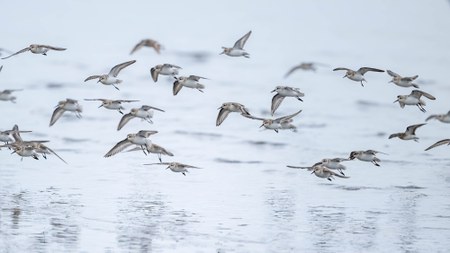
Become a beach-side naturalist in our upcoming seminar designed to help you develop your shorebird identification skills. Offered by the Seattle Naturalist Committee on Sep 13 at 7pm, Introduction to Shorebirds of the Pacific Northwest will open your eyes to the stunning beauty of our local shorebirds.
Shorebird Trip Report
"Shorebirds," Bruce yelled. Several hundred birds wheeled back and forth, showing their white undersides as they all went one way before revealing their darker backsides. Back and forth, they twisted and turned, almost landing in the shallows before taking flight and making another loop. Soon more arrived, and the numbers swelled to over a thousand. It was nearly high tide at Bill's Spit in Ocean Shores. They were coming to roost after feeding for several hours. Finally, some landed in the shallows, peeps, the smallest of the shorebirds in Western Washington.
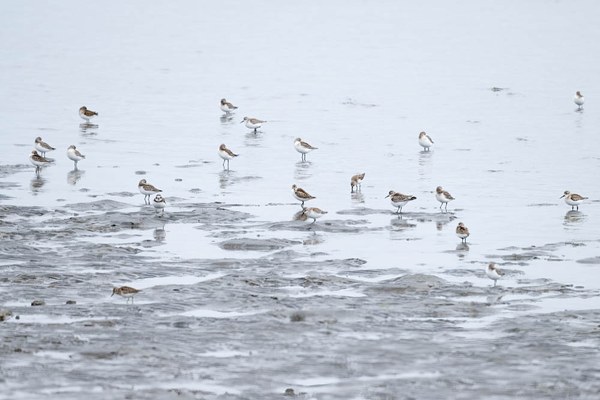 Western Sandpipers, Least Sandpipers, and Semipalmated Plovers work the beach at Bill's Spit. All photos by Thomas Bancroft.
Western Sandpipers, Least Sandpipers, and Semipalmated Plovers work the beach at Bill's Spit. All photos by Thomas Bancroft.
We snapped up our spotting scopes and began to scan. Most were Western Sandpipers, with clear, almost white chests and a slight droop to their bills. In the swarm were a few smaller birds with buffy chests and yellow legs - Least Sandpipers. I swiveled the scope back and forth, checking the growing horde; maybe 10% were Leasts. These species are only 6 inches long, the length of a pencil. Both had arrived in the last few weeks from breeding grounds in the Arctic. It is mind-boggling to think these tiny organisms flew 1,800 miles to get here, and when they fatten back up most will head farther south, maybe spending the winter in Panama, California, or perhaps even Peru.
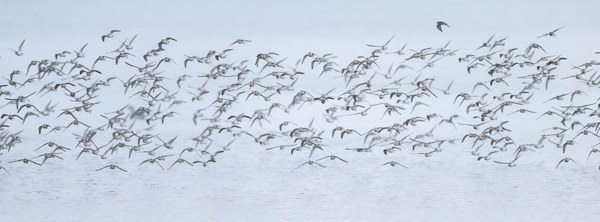 Hundreds of Western and Least sandpipers twist and turn as they prepare to land at high tide to rest on the beach.
Hundreds of Western and Least sandpipers twist and turn as they prepare to land at high tide to rest on the beach.
"Do you see the Semipalmated Plover," Bruce called, "and there are some godwits and dowitchers in with the gulls and terns on the spit." I looked more carefully at the churning multitude on the sand and found an equally small bird with a chest band and bi-colored bill. Bruce and I were on a two-day scouting trip for a possible naturalist activity for The Mountaineers. This was our last stop before heading back to Seattle.
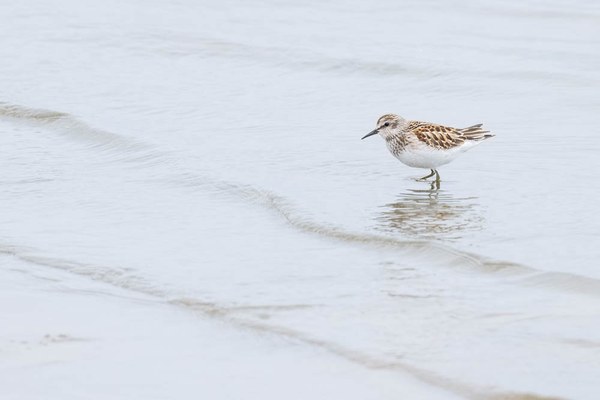 A Least Sandpiper feeds in the shallows.
A Least Sandpiper feeds in the shallows.
The day before we'd started with a hike along Bottle Beach. The fog had been dense, but the shorebirds were at the surf's edge. We found a place to wait and let the rising tide push the birds toward us. Hundreds of Black-bellied Plovers, some still in their black tuxedos from breeding, others into their drab winter attire, and many in transition, came closer and closer. Greater Yellowlegs, Semipalmated Plovers, Marbled Godwits, and many peeps worked the shallows, looking for breakfast morsels. The best plan for Bottle Beach is to arrive two hours before high tide and wait. I'd been there in April and May for the spring migration when everything was headed north, and this was my first try at catching their southern trek.
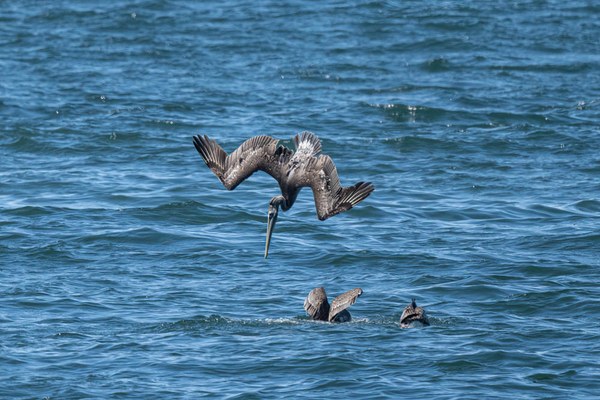 A Brown Pelican dives for fish near Westport, Washington.
A Brown Pelican dives for fish near Westport, Washington.
That afternoon, we walked places near Westport and Tokeland. We found many shorebirds, most headed south, but we also watched many flocks of Brown Pelicans feeding in the bays and found several large groups of Heerman's Gulls. The pelicans plunge dive. From as much as 20 or 30 feet above the water, they will twist and drop straight into it, bill first, like a knife. After that long bill slices into the ocean, they open it, and their pouch forms a large fishing bag. If they catch something, they raise their heads to let the water drain out and throw the fish back into their gullet. Pelicans breed in California and Mexico, and the Heerman's in the Gulf of California and off Baja. After breeding, both species drift north for the summer and fall before heading back down. It is an interesting "reverse" migration.
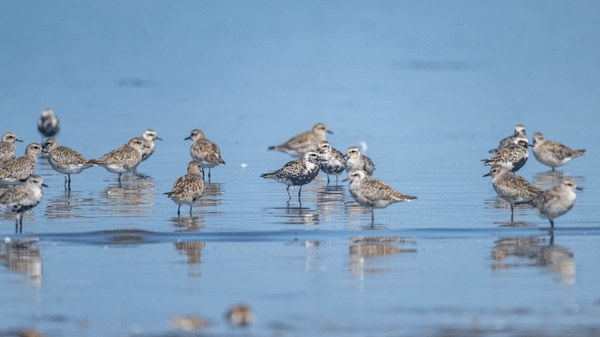 Black-bellied Plovers at Bottle Beach show the variety of plumages they have in the fall.
Black-bellied Plovers at Bottle Beach show the variety of plumages they have in the fall.
The beaches, spits, and jetties of Ocean Shores were our destination for the second morning. Unfortunately the fog was thick, and we were unsuccessful in searching the jetties for several shorebird species that frequent rocks. However, we did spend a half-hour watching a Wandering Tattler work some boulders near Damon Point. I'd not seen this species in decades; it was a first for Bruce. This bird, also down from the Arctic, walked over the rocks, probing in the alga, and at one point, it caught a fly, flipping it into its open mouth.
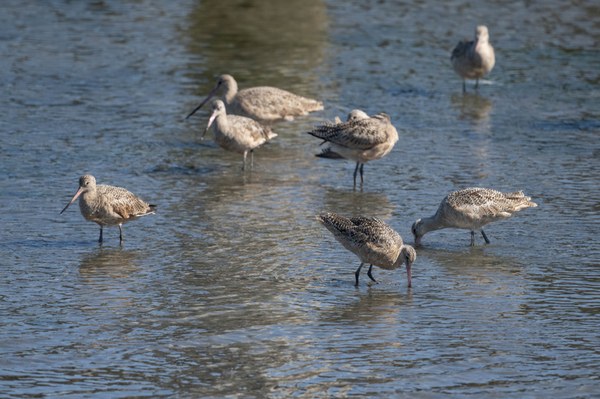 Marbled Godwits feed and rest in the shallows at Tokeland Marina.
Marbled Godwits feed and rest in the shallows at Tokeland Marina.
Shorebirds can be challenging to identify. Most change plumages between summer and winter, and many species look very similar in winter. At the Owhut Wildlife area, we wrestled with the identification of four plovers, trying to decide which of two golden-plover species they might be. The shorter projection of their wings past the tail finally confirmed they were Pacific Golden-Plovers.
We ended with fourteen species of shorebirds and 57 bird species overall. It was a good drive back to Seattle, with lots for us to discuss.
 Thomas Bancroft
Thomas Bancroft
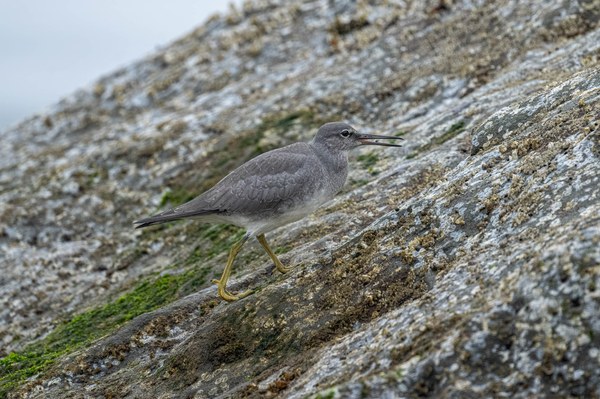 A Wandering Tattler tosses a fly in the air and then gulps it down. Damon Point.
A Wandering Tattler tosses a fly in the air and then gulps it down. Damon Point.